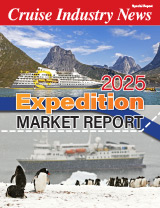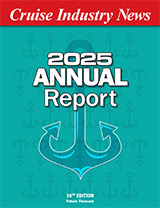Passenger Ship Safety continued in Southampton on Wednesday with a full-scale event program, conference and seminar. Speakers including representatives from coast guards, cruise lines and other key stakeholders in the cruise ship safety arena.
“Safety rules today are reasonably steady, the focus is now on implementation,” commented Katy Ware, director of maritime safety and standards and permanent representative of the UK to the IMO, Maritime and Coastguard Agency.
Among the adjustments, she explained, is a new safety index linked to a ship’s passenger capacity; as large ships remain a concern for safety stakeholders ashore.
Video safety is taking over too, said Rick Jeffress, director of business development for Fike Fire Safety. CCTV systems can see fire and also detect pressure leaks, he said. Video can produce a clear image before smoke finds its way to a detector, he said, adding the system is already in use aboard a number of ships from major cruise lines.
Cyber security is also becoming an increasing concern for the industry, according to Phil Tinsley, maritime security manager at BIMCO. A cyber-attack could, for example, compromise safety and emergency management onboard.
He advised better training against cyber attacks, and some ships had multiple points of vulnerability. Tinsley added some vessels were using the same computers they had 15 years ago, with outdated software and a lack of intrusion detection.
“We have to develop a cyber-security awareness culture,” Tinsley noted.
Brad Schoenwald, senior marine inspector/ lead examiner for the Cruise Ship National Expertise and the United States Coast Guard explained the agency’s role in overseeing new ship construction
“People can be confident that we do our job to verify that the ships coming to the U.S. are as safe as required,” he said. The agency is involved in concept to delivery and performs routine inspections when ships are in U.S. waters.
“We go onboard, we identify the deficiencies and their sources. All of that goes to the Port State Control Database, which is accessible to the public,” Schoenwald said.
At Carnival UK, Martyn Thomas, acting head of maritime training, said the company goes beyond compliance.
He said the old-fashioned training model, with a classroom and homework is long ports. The training program now fits with people, generations, skills, including formal training, information training and job experience.
He said that among the goals was to improve training efficiency.
“Our crew can learn from any single drill,” he noted. On-going training for officers, including routine trips to a simulator center in the Netherlands, are not additional work, he said, but instead seen as a long-term tool that can be used daily.
Joska Taipale, technical support and training adviser at Marioff, pointed to the company’s high-pressure water mist system (HI-FOG) as key to fire suppression.
“Our system is simple,” he said. The systems can be activated in as little as 30 seconds. This is as opposed to CO2 systems, which can take up to 30 minutes to deploy after spaces are evacuated and ventilation shut off.
Wiel Penders, executive vice president of sales and operations at DASPOS, talked about the company’s oil mist and gas leakage detection systems, that can analyze air for oil or gas.
Penders is a former Carnival Corporation and Holland America Line executive that played a key role in the company’s fire prevention programs.
Autotronica showed off its integrated safety management system with a presentation by Kai Thrones, vice president maritime.
By monitoring CCTV, fire zones, damage control, ventilation and more, the system can provide a complete and customizable view of an emergency, aligning with bridge resource management. The system can also be linked to passenger tracking should that technology continue to evolve.
Andrew Winbow, former assistant secretary-general and director, maritime safety division for the IMO, said it was clear there are modern solutions to fight fires as well as increasingly impressive but complex automation systems, meaning a future where the onboard IT department may play a major role.



